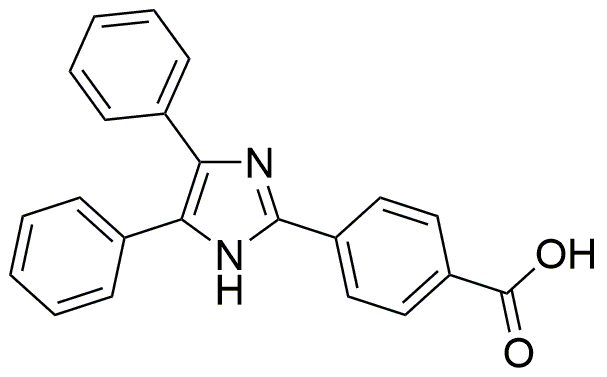4-(4,5-Diphenyl-1H-imidazol-2-yl)benzoic acid is widely utilized in research focused on:
- Pharmaceutical Development: This compound serves as a key intermediate in the synthesis of various pharmaceuticals, particularly in the development of anti-cancer agents, due to its ability to inhibit specific enzymes involved in tumor growth.
- Material Science: It is employed in the creation of advanced materials, including polymers and coatings, that exhibit enhanced thermal stability and mechanical properties, making them suitable for high-performance applications.
- Biochemical Research: The compound is used in studies investigating enzyme interactions and cellular processes, providing insights into metabolic pathways and potential therapeutic targets.
- Analytical Chemistry: It acts as a reference standard in analytical methods such as HPLC and mass spectrometry, ensuring accurate quantification and characterization of related compounds in various samples.
- Organic Synthesis: Researchers utilize this compound as a building block in organic synthesis, facilitating the creation of complex molecules with specific functional groups, which are essential in various chemical reactions.
General Information
Properties
Safety and Regulations
Applications
4-(4,5-Diphenyl-1H-imidazol-2-yl)benzoic acid is widely utilized in research focused on:
- Pharmaceutical Development: This compound serves as a key intermediate in the synthesis of various pharmaceuticals, particularly in the development of anti-cancer agents, due to its ability to inhibit specific enzymes involved in tumor growth.
- Material Science: It is employed in the creation of advanced materials, including polymers and coatings, that exhibit enhanced thermal stability and mechanical properties, making them suitable for high-performance applications.
- Biochemical Research: The compound is used in studies investigating enzyme interactions and cellular processes, providing insights into metabolic pathways and potential therapeutic targets.
- Analytical Chemistry: It acts as a reference standard in analytical methods such as HPLC and mass spectrometry, ensuring accurate quantification and characterization of related compounds in various samples.
- Organic Synthesis: Researchers utilize this compound as a building block in organic synthesis, facilitating the creation of complex molecules with specific functional groups, which are essential in various chemical reactions.
Documents
Safety Data Sheets (SDS)
The SDS provides comprehensive safety information on handling, storage, and disposal of the product.
Product Specification (PS)
The PS provides a comprehensive breakdown of the product’s properties, including chemical composition, physical state, purity, and storage requirements. It also details acceptable quality ranges and the product's intended applications.
Certificates of Analysis (COA)
Search for Certificates of Analysis (COA) by entering the products Lot Number. Lot and Batch Numbers can be found on a product’s label following the words ‘Lot’ or ‘Batch’.
*Catalog Number
*Lot Number
Certificates Of Origin (COO)
This COO confirms the country where the product was manufactured, and also details the materials and components used in it and whether it is derived from natural, synthetic, or other specific sources. This certificate may be required for customs, trade, and regulatory compliance.
*Catalog Number
*Lot Number
Safety Data Sheets (SDS)
The SDS provides comprehensive safety information on handling, storage, and disposal of the product.
DownloadProduct Specification (PS)
The PS provides a comprehensive breakdown of the product’s properties, including chemical composition, physical state, purity, and storage requirements. It also details acceptable quality ranges and the product's intended applications.
DownloadCertificates of Analysis (COA)
Search for Certificates of Analysis (COA) by entering the products Lot Number. Lot and Batch Numbers can be found on a product’s label following the words ‘Lot’ or ‘Batch’.
*Catalog Number
*Lot Number
Certificates Of Origin (COO)
This COO confirms the country where the product was manufactured, and also details the materials and components used in it and whether it is derived from natural, synthetic, or other specific sources. This certificate may be required for customs, trade, and regulatory compliance.


